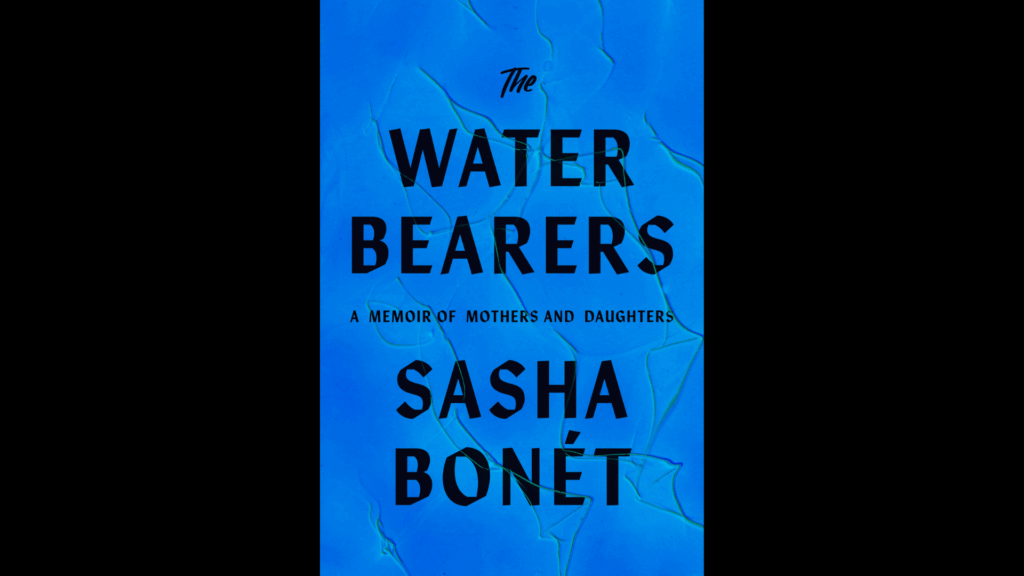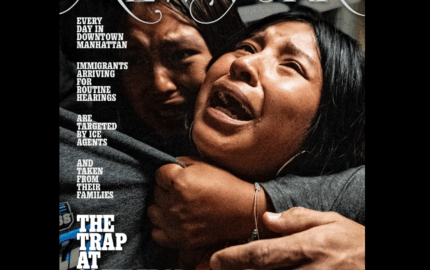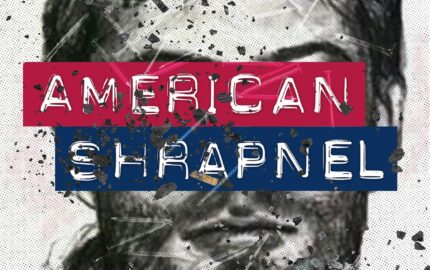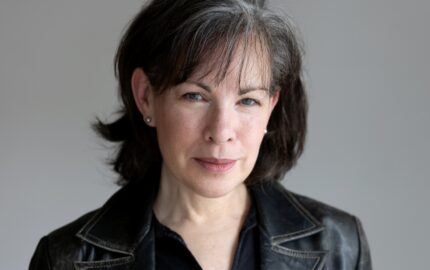Writer, critic, and editor Sasha Bonét joins Storyboard contributor Christina M. Tapper on this week’s episode of the Nieman Storyboard podcast, in a wide-ranging conversation about Bonét’s writing process for “The Waterbearers,” a memoir about mothers and daughters. Bonét and Tapper discuss surrendering to how a story unfolds, rather than forcing it, and how to turn a physical place into a key character.
Bonét, a professor of creative writing for Columbia University and Barnard College, has written for The Paris Review, Aperture, New York magazine, and Vogue. “The Waterbearers” is her book debut. At the heart of it, the book “is an American family story,” Bonét says. “In the Black American family oftentimes it is a matriarchal family, and that kind of queers the traditional American setup that we understand, which is that the man is at the head of the household. [The book goes] through my family lineage, but it's also connecting to different policies and histories that impact the way the Black family is structured.
“I wanted to look at American history through the lens of the women that helped to really birth this nation from the beginning of the empire to understand an alternative viewpoint from the people who are often disregarded.”
[ Follow us in Apple Podcasts, Spotify, or your favorite podcast app. ]
Water is a major theme in the book, and it provides Bonét a through line in telling not just her family’s matrilineal story, but also the history of Black womanhood and motherhood in the U.S. The theme didn’t reveal itself until Bonét conducted interviews with her grandmother Betty Jean, her mother, Connie, and her six aunts.
“ The water kept coming to me. I actually wasn't trying to chase it. It was something that, when the women in my family were sharing their stories with me, there was always water. It was a metaphor or it was present, or they were talking about their baptisms. Everything was kind of situated around their proximity to water,” Bonét says. “The water helped as a kind of grounding principle for structure, but also for how I was thinking about writing.”
Bonét says she loves to “leave a lot of room for the story to shape itself. For example, if I'm writing criticism, if I'm interviewing or doing research, I don't want to go into it with my own idea or concept. I like for it to be shaped by what I discover. I allow a lot of space for the interviews and the research to help me build an idea of what I will write about. So that was the case for the book. ... I allow myself to be carried in the direction that the research takes me.”
To help thread the stories of her family with her own experiences as a mother, daughter, and granddaughter, Bonét made her grandmother’s house in Houston, known as 5010, a central character.
“I didn't even really identify the significance of the house until I was writing about it,” Bonét says. “Physical space is really important for this family. But, also I think specifically for people who lack a kind of origin, to have a place that they can ground themselves in. A place to gather and a place where you can always go. What a gift. I had a lot of fun with that.”
During the conversation, Bonét also shares how collage and creating a writing altar helped her bring “The Waterbearers” to life. The excerpts below are edited for length and clarity.
On the importance of interviewing her aunts in birth order before talking to her mother:
My grandmother had 11 children. I spoke with all the daughters. I didn't interview her sons. I really wanted to get the story through the gaze of the women and the daughters. And the order in which I interviewed them was really important. Birth order, to me, plays such a significant role in how we engage with the world because we're kind of given a position that we didn't ask for. The way we are able to situate ourselves within our family of course carries over into the way we engage with everyone else outside the house.
And so I looked at the birth order and I thought, “Okay, I spoke with Granny. Who's next?” I started with the eldest. And you know, the first child is always having to be a bit of a guinea pig. [My grandmother] was very young when she had her. [My aunt] also allowed for a kind of permission because she's quite stoic and doesn't speak very much.
And then I went around my mother because I knew she would be the hardest one to speak with. So then I interviewed all her sisters, and then I came back to her because I knew that she would want to correct. And so I said, “Well, you know, you don't have to speak with me, but I'm telling the story and I've spoken with all your sisters.” And she's like, “What? What did they say?” And then she's like, “Oh, they got it all wrong. I have to tell you what really happened.”
It was really important to think about how to organize the interviews and how to move through the family structure in a way that would allow me more openness.
On making her grandmother’s house a key character:
In a practical sense, I needed to include it because I had so many characters. … I needed a place where everyone could be in one room. I think in telling any story, whether it's in film or writing, you need a place. “Seinfeld” had a place; “Friends” had a place. There always needs to be a place where all the characters can be in one setting, and then the main characters can kind of exist outside of that. So I thought I would place them there. But then as I started situating them, I really got into writing about the house. ... You know, when you spend time at a place, you just kind of don't see it. It's like an extension of your own skin. When I sat to think about it, what is 5010? What does it represent? What does it feel like? What does it look like? I was like, oh, wow, this is so rich … and the more I thought about it, it is a character.
On managing pushback from her editor about the opening of the book:
I wanted to define “waterbearer” from the beginning. When I wrote [the prelude], I was kind of writing it for myself. Like, what even is this waterbearer? I had already finished the first draft of the book before I wrote that. …I wrote this in one sitting. I sent it to a friend and she was like, “Yes.” My editor, John Freeman, was like, “No.” [He said,] “This voice is too different. The reader who picks up your book at a bookstore is gonna read this and they're gonna think that this is what the book is like, and it's not.”
[But] I just felt so strongly about [including it]. Me and my editor have such a wonderful relationship and he usually doesn't push back on me so much when I feel adamant. … [The prelude] just flowed. And when things come to me in that way, I feel really strongly about them. … I thought, I have to honor whatever this was that came through. And you know, sometimes you have these things come through and they get past you. They kind of slip through your fingers. And then sometimes you can grab ‘em. And this was one of those moments where something came through and I was able to grab it. I felt that it was necessary. And so [John] said, “Okay.” And then there were some other people at Knopf that were like, “Yeah, we love this.”
On creating an ancestral altar in her ‘writer’s womb’:
I just needed a place of my own — very Virginia Woolf. And because it was post-pandemic, so many office buildings were empty. So I was able to find something really inexpensive in Manhattan. It wasn't until I moved in that I realized this is the first place I've had of my own in the past 15 years since I had my daughter.
It was small. I painted it pink. I called it the “writer's womb.” It was this little place that held me. I set up an altar with all of all these women. I was writing about ancestors, but also all of these women and writers, like James Baldwin, Toni Morrison, Maya Angelou. W.E.B. Du Bois. All of these people before me who’ve kind of paved the way, and I just put them all on this altar. I would start my day at the altar and say, “Okay, I'm here. Please guide me. Give me the courage to go where you asked me to go. Give me the courage to say the truth.” ... I started with the same kind of chant, meditation, every morning to ground myself and to remind myself that I'm a part of a lineage of people who have been practicing this craft.
On ending the book with a collage:
I'd written this piece for The Paris Review about Lorna Simpson and Breonna Taylor. And I had started collaging with my daughter during the pandemic. So that was on my mind. Leslie Jamison from Columbia University read that piece and contacted me and asked me to do an online guided workshop about collaging and its relationship to writing.
This is during the pandemic. Everything's on Zoom. So I'm creating this collage for this workshop that I'm guiding. And I ended up just loving it and I just held onto it. I framed it, I named it. I actually wanted to name the book, “Water Is a Body Too.” That was the original title that I had on my proposal … I just thought it was symbolic… So I wanted it to be included in the end, as a testament to the entire process.
Reading, Listening, and Visual Art List:
- “The Waterbearers” (Sasha Bonét, 2025)
- “The Artist Who Gave Up Her Daughter” (originally published in Topic, May 18, 2019, and included in “The Waterbearers”)
- “Waterbearer” by Lorna Simpson
- Femi Adeyemi
- Rakia Clark
- “Wayward Lives, Beautiful Experiments: Intimate Histories of Social Upheaval” (Saidiya Hartman, 2019)
- “White Girls” (Hilton Als, 2019)
- Katy Morlas Shannon
- “‘His Name Was Bélizaire’: Rare Portrait of Enslaved Child Arrives at the Met” (The New York Times, August 24, 2023)
- “Water has perfect memory ...” (Toni Morrison, “The Site of Memory”)
- “what the mirror said” by Lucille Clifton
- “Reimagining Black Futures” (The Paris Review, June 24, 2020)
- Leslie Jamison
Show credits
Hosted and produced by Mark Armstrong
Episode producer and interview by Christina M. Tapper
Episode editor: Kelly Araja
Audience editor: Adriana Lacy
Promotional support: Ellen Tuttle
Operational support: Paul Plutnicki, Peter Canova
Nieman Foundation interim curator: Henry Chu
Music: “Golden Grass,” by Blue Dot Sessions (www.sessions.blue)
Cover design by Adriana Lacy
Nieman Storyboard is presented by the Nieman Foundation for Journalism at Harvard.
***
Subscribe to Storyboard
Get insights into the craft of journalism and storytelling in your inbox, delivered on Fridays.





